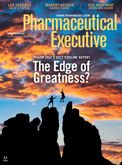The Pipeline: Pressures from Beyond
Pharmaceutical Executive
The influx of treatment breakthroughs and expanding science has not silenced the debate over the productivity of biopharma's R&D model, and the looming challenges for R&D decision-makers.
This month, Pharm Exec takes its annual peek at the progress of the industry’s new drug pipeline. Not only is there much to please the expectant eye of Wall Street investors, the basic science behind it is getting better still. According to the FDA, 10 of the 18 novel compounds approved through mid-October received special designation as a priority, breakthrough or first-in-class therapy. That’s welcome news for patients with hepatitis C, where two
William Looney

additional cures enter an increasingly competitive market, to under-treated conditions like plaque psoriasis, bladder cancer and Parkinson’s-related psychosis.
Significantly, however, these accomplishments have not silenced debate over the productivity of biopharma’s R&D model. For the big pharma top 10, in-house innovation continues to lag opportunistic “buy to thrive” assets acquired externally, often at premium prices. The five structural R&D failures identified by AstraZeneca in a frank 2014 self-analysis published in Nature-not finding the right target, nor the right assay, the right margin of safety, the right patient study population, or the right measure of value-remain top-of-mind among R&D managers today. A crisis of confidence persists, even though the spread-your-bets “multiple shots on goal” metric that helped precipitate these failures is no longer part of the C-suite conversation.
According to Harvard graduate researcher Mark Lipstein, the biggest challenge to drug R&D is reconciling the sequential, step-by-step precision of the scientific method against the complexity of today’s disease targets. “Scientists like to construct their research models in the classic mode, one element at a time, but this runs up against the inconceivably deep layers of interactions among the genes, proteins and cells that express in the physiology of every individual,” he says. “If you add to these interactions an external modifier like a new drug, and then seek a replicable result after multiple test comparisons, there is a strong possibility that too much extraneous “noise” will bias that result, leading to a dead end-often after years of effort.”
Lipstein’s comment explains why the real push in R&D productivity is in commercializing the next generation of research tools, replacing small molecule chemistry, including the widely discredited animal test model, with hard data, bioinformatics and other multi-disciplinary approaches. The goal is to make deconstructing all this biologic complexity easier for scientists to direct their efforts to activities that carry a higher prospect of therapeutic success-hopefully at lower cost. Elsewhere in this month’s issue, Veeva Systems CEO Peter Gassner highlights how big pharma has little choice but to embrace these new tools or face the consequences as high tech outsiders seize the advantage.
We must also be mindful that meeting the conditions for regulatory approval remains the most reliable guide to R&D managers’ decisions on when, where and how to deploy the resources necessary to advance their pipelines. That’s why the FDA must avoid giving mixed signals on this score, as some observers say it has done in acceding to patient pressure by approving the first drug to treat Duchenne muscular dystrophy, despite inconclusive evidence of efficacy in a small, 12-person clinical trial. Although a larger follow-on study has been mandated to buttress the claim that the drug, Exondys 51, actually works, the FDA decision to allow marketing status confirms a gathering trend to politicization of the drug approval standard of proof.
As research breakthroughs continue to advance the boundaries of what’s possible in treatments, we can expect more such coordinated campaigns as desperate patients with no other options to stave off mortality seek to bend the FDA rules in their favor. It raises questions about the durability of a process established many decades ago to reflect the state of the science, not the strength of interest groups.
A disease is a disease-or is it?
Another looming challenge in drug research is how our expanding knowledge of molecular targets that lead to new drugs, combined with the ability to personalize such treatments, can make it harder to obtain the necessary clinical consensus on defining the disease state, fixing a standard diagnosis and, ultimately, making a new treatment reimbursable by insurers. Neurology is one discipline where this question has already surfaced, personified in a growing movement of disease deniers committed to the idea of “neurodiversity.” Is autism-the fastest-growing developmental disorder in the US today-a disease that must be “cured” with a drug? Or is it simply the expression of normal variations in an individual’s genetic profile, reinforced by random environmental influences, which do not automatically require a drug intervention?
Here is the paradox: In the years ahead, as the frontiers of science expand, R&D decision-makers may have to temper their enthusiasm and adapt to changing social norms about what constitutes the state of being ill. No one size fits all.
William Looney is Editor-in-Chief of Pharm Exec. He can be reached at william.looney@ubm.com. Follow Bill on Twitter: @BillPharmExec

Study: GLP-1, SGLT2s Linked to Reduced Alzheimer Disease Risk in Patients with Type 2 Diabetes
April 17th 2025A new study found that patients with type 2 diabetes treated with GLP-1 receptor agonists and sodium-glucose cotransporter-2 inhibitors demonstrated lower risks of developing Alzheimer disease compared to other glucose-lowering drugs.
Addressing Disparities in Psoriasis Trials: Takeda's Strategies for Inclusivity in Clinical Research
April 14th 2025LaShell Robinson, Head of Global Feasibility and Trial Equity at Takeda, speaks about the company's strategies to engage patients in underrepresented populations in its phase III psoriasis trials.
Key Findings of the NIAGARA and HIMALAYA Trials
November 8th 2024In this episode of the Pharmaceutical Executive podcast, Shubh Goel, head of immuno-oncology, gastrointestinal tumors, US oncology business unit, AstraZeneca, discusses the findings of the NIAGARA trial in bladder cancer and the significance of the five-year overall survival data from the HIMALAYA trial, particularly the long-term efficacy of the STRIDE regimen for unresectable liver cancer.